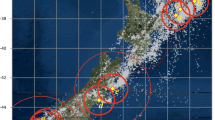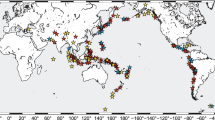Abstract
Aftershock sequences have been identified for 60 earthquakes (K ≥ 11) from the catalog of the Institute of Seismology, National Academy of Sciences, Kyrgyz Republic (to be referred to as KIS in what follows). The catalog includes 56 259 events that have occurred in Tien Shan and North Pamir during the period from 1980 to 2001. We have obtained some statistical characteristics of the catalog and determined its completely reported part. A map of seismic activity has been made. We determined some parameters of main events and aftershock sequences. The lowest number of aftershocks was 3 events, the largest number was 2370, the shortest duration of the aftershock process was 2 days and the longest 2046 days. The earthquake catalog and the aftershock sequences were treated from the standpoint of nonequilibrium thermodynamics using the Tsallis statistic (the parameters q and a). We sought to obtain a description of earthquakes over energy using a modified stick-slip earthquake source model and the principle of maximum entropy. This approach was used to obtain a quantitative estimate of the nonextensive Tsallis parameter q for seismicity, as well as to estimate the variation of that parameter just before a large earthquake and during aftershocks. It was shown that seismicity is a system with memory and long-range spatial correlations. The Tsallis parameter q for aftershock sequences exceeds the value of q based on the entire catalog, thus indicating an unstable state of the earthquake-generating system during aftershocks. One observed a sharp increase in the Tsallis parameter q in an area that includes the precursory area before the main event and a sharp drop at once after it, gradually returning to the average level observed before the main event.











Similar content being viewed by others
REFERENCES
Abdrakhmatov, K.E., Uildon, R., Tompson, S., et al., The origin, direction, and rate of present-day compression affecting Central Tien Shan, Kirgizia, Geol. Geofiz., 2001, vol. 42, no. 10, pp. 1585–1610.
Baranov, S.V. and Shebalin, P.N., Zakonomernosti post-seismicheskikh protsessov i prognoz opasnosti silnykh aftershokov (Patterns in Postseismic Processes and Predicting the Hazard Posed by Large Aftershocks), Moscow: RAN, 2019.
Brown, S.R., Scholz, C.H., and Rundle, J.B., A simplified spring-block model of earthquakes, Geophys. Res. Lett., 1991, vol. 18, no. 2, pp. 215–218.
Chumak, O.V., Entropiya i fraktaly d dannykh (Entropy and Fractals in Data), Moscow, Izhevsk: NITs Regul. Khaot. Din., Institut Komp. Issled., 2011.
Complexity of Seismic Time Series: Measurement and Application, T. Chelidze, F. Vallianatos, and L. Telesca, Eds., Amsterdam, Netherlands: Elsevier, 2018. https://www.elsevier.com/books/complexity-of-seismic-time-series/chelidze/978-0-12-813138-1
Gibbs, J.W., The Scientific Papers of, 2 vols., Woodbridge, CT: Ox Bow Press, 1993.
Gutenberg, B. and Richter, C.F., Frequency of earthquakes in California, Bull. Seismol. Soc. Am., 1944, vol. 34, pp. 185–188.
Kalimeri, M., Papadimitriou, C., Balasis, G., and Eftaxias, K., Dynamical complexity detection in pre-seismic emissions using nonadditive Tsallis entropy, Physica A: Statistical Mechanics and its Applications, 2008, vol. 387, nos. 5–6, pp. 1161–1172.
Chochlaki K., Complexity of the Yellowstone Park Volcanic Field Seismicity in Terms of Tsallis Entropy, K. Chochlaki, G. Michas, and F. Vallianatos, Eds., Entropy, 2018, vol. 20. https://doi.org/10.3390/e20100721
Kasahara, K., Earthquake Mechanics, Cambridge University Press, 1981.
Kostyuk, A.D., Deformation changes in the crust of northern Tien Shan from data of space geodesy, Vestnik KRSU, 2008, vol. 8, no. 3, pp. 140–144.
Kuchay, O.A., Kalmet’eva, Z.A., Kozina, M.E., and Abdrakhmatov, K.E., Stress fields revealed by aftershocks of the strongest earthquakes of Tien Shan, Geodynamics & Tectonophysics, 2017, no. 8(4), pp. 827–848. https://doi.org/10.5800/GT-2017-8-4-0319
Matcharashvili, T., Chelidze, T., Javakhishvili, Z., et al., Non-extensive statistical analysis of seismicity in the area of Javakheti, Georgia, Comput. Geosci., 2011, vol. 37, pp. 1627–1632.
Molchan, G.M. and Dmitrieva, O.E., Aftershock identification: methods and new approaches, Geophysical Journal International, 1992, vol. 109, pp. 501–516.
Mukhamadeeva, V.A. and Sucheva, N.A., On the aftershock processes that follow moderate and small earthquakes in the Bishkek Geodynamic Test Site area and around it, Geosistemy Perekhodnykh Zon, 2018, vol. 2, no. 3, pp. 165–180.
Muraliev, A.M. and Iskenderov, S.A., On the procedure to apply to the identification of aftershocks following large earthquakes, Vestnik Inst. Seismol. NAN KR, 2015, no. 1, pp. 80–87.
Papadakis, G., A Non-Extensive Statistical Physics Analysis of Seismic Sequences: Application to the Geodynamic System of the Hellenic Subduction Zone, PhD Thesis. London: University College, 2016.
Papadakis, G., Vallianatos, F., and Sammonds, P., Evidence of nonextensive statistical physics behavior of the Hellenic subduction zone seismicity, Tectonophysics, 2013, vol. 608, pp. 1037–1048.
Papadakis, G., Vallianatos, F., and Sammonds, P., A nonextensive statistical physics analysis of the 1995 Kobe, Japan earthquake, Pure Appl. Geophys., 2015, vol. 172, pp. 1923–1931.
Papadakis, G., Vallianatos, F., and Sammonds, P., Non-extensive statistical physics applied to heat flow and the earthquake frequency-magnitude distribution in Greece, Physica A: Statistical Mechanics and its Applications, 2016, vol. 456(C), pp. 135–144.
Prigogine, I. and Stengers, I., Order out of Chaos: Man’s New Dialogue with Nature, Flamingo, 1985.
Rautian, T.G., Earthquake energy, Metody Detalnogo Izucheniya Seismichnosti, Moscow: AN SSSR, 1960, no. 176, pp. 75–114.
Rebetsky, Yu.L. and Alekseev, R.S., The field of recent tectonic stresses in Central and SouthEastern Asia, Geodynamics & Tectonophysics, 2014, no. 5(1), pp. 257–290. https://doi.org/10.5800/GT2014510127
Riznichenko, Yu.V., Problemy seismologii (Problems in Seismology), Moscow: Nauka, 1985.
Sarlis, N.V., Skordas, E.S., and Varotsos, P.A., Nonextensivity and natural time: The case of seismicity, Phys. Rev. E 82 (American Physical Society (APS)), 2010. 021110. P. 021110-1–021110-9. https://doi.org/10.1103/physreve.82.021110
Shebalin, P.N., Baranov, S.V., and Dzeboev, B.A., The recurrence law for aftershock rate, Dokl. Akad. Nauk, 2018, vol. 481, no. 3, pp. 320–323.
Silva, R., Franca, G.S., Vilar, C.S., and Alcanis, J.S., Nonextensive models for earthquakes, Phys. Rev. E Stat. Nonlin. Soft Matter Phys., 73(2 Pt 2), 2006, 026102. P. 026102-1–026102-5. https://doi.org/10.1103/PhysRevE.73.026102
Sobolev, G.A. and Ponomarev, A.V., Fizika zemletryasenii i predvestniki (Earthquake Physics and Precursors), Moscow: Nauka, 2003.
Sotolongo-Costa, O. and Posadas, A., Fragment-asperity interaction model for earthquakes, Phys. Rev. Lett., 2004, vol. 92, no. 4, pp. 048501-1–048501-4. https://doi.org/10.1103/PhysRevLett.92.048501
Sychev, V.N., Sycheva, N.A., and Imashev, S.A., A study of the aftershock sequence following the Suusamyr earthquake, Geosistemy Perekhodnykh Zon, 2019, vol. 3, no. 1, pp. 35–43. https://doi.org/10.30730/2541-8912.2019.3.1.035-043
Sycheva, N.A. and Mansurov, A.N., Comparison of crustal deformation rates estimated from seismic and GPS data on the Bishkek geodynamic polygon, Geodynamics & Tectonophysics, 2017, no. 8(4), pp. 809–825. https://doi.org/10.5800/GT-2017-8-4-0318
Telesca, L., Analysis of Italian seismicity by using a nonextensive approach, Tectonophysics, 2010a, vol. 494, pp. 155–162.
Telesca, L., Nonextensive analysis of seismic sequences, Phys., 2010b, A 389, pp. 1911–1914.
Telesca, L., A non-extensive approach in investigating the seismicity of L’ Aquila area (central Italy), struck by the 6 April 2009 earthquake (ML 55.8), Terra Nova, 2010c, vol. 22(2), pp. 87–93.
Telesca, L., Tsallis-based nonextensive analysis of the Southern California seismicity, Entropy, 2011, vol. 13(7), pp. 127–1280. https://doi.org/10.3390/e13071267
Telesca, L. and Chen, C.C., Nonextensive analysis of crustal seismicity in Taiwan, Nat. Hazards Earth Syst. Sci., 2010, vol. 10, pp. 1293–1297. https://doi.org/10.5194/nhess-10-1293-2010
Telesca, L., Cuomo, V., Lapenna, V., et al., Analysis of the temporal properties of Greek aftershock sequences, Tectonophysics, 2001, vol. 341(1–4), pp. 163–178.
Tsallis, C., Possible generalization of Boltzmann-Gibbs statistics, J. Statistical Physics, 1988, vol. 52(1–2), pp. 479–487. https://doi.org/10.1007/bf01016429
Vallianatos, F., Michas, G., and Papadakis, G., Non-extensive and natural time analysis of seismicity before the Mw6.4, October 12, 2013 earthquake in the South West segment of the Hellenic Arc, Physica A: Statistical Mechanics and its Applications, 2014, vol. 414, pp. 163–173. https://doi.org/10.1016/j.physa.2014.07.038
Valverde-Esparza, S.M., Ramirez-Rojas, A., Flores-Marquez, E.L., and Telesca, L., Non-extensivity analysis of seismicity within four subduction regions in Mexico, Acta Geophys., 2012, vol. 60, pp. 833–845.
Yudakhin, F.N., Geofizicheskie polya, glubinnoe stroenie i seismichnost Tyan Shanya (The Geophysical Fields, Deep Structure and Seismicity of Tien Shan), Frunze: Ilim, 1983.
Zav’yalov, A.D., Srednesrochnyi prognoz zemletryasenii: Osnovy, metodika, realizatsiya (Intermediate-Term Earthquake Prediction: Principles, Procedures, Implementation), Moscow: Nauka, 2006.
Zubovich, A.V. and Mukhamediev, Sh.A., A method of superimposed triangulations for calculation of velocity gradient of horizontal movements: application to the Central Asian GPS network, Geodynamics & Tectonophysics, 2010, vol. 1, no. 2, pp. 169–185.
Funding
This work was supported in part by a state assignment of the Federal State Science Institution “Research Station of the Russian Academy of Sciences in Bishkek city” (topics AAAA-A19-119020190064-9 and AAAA-A19-119020190066-3).
Author information
Authors and Affiliations
Corresponding author
Additional information
Translated by A. Petrosyan
Rights and permissions
About this article
Cite this article
Sychev, V.N., Sycheva, N.A. Nonextensive Analysis of Aftershocks Following Moderate Earthquakes in Tien Shan and North Pamir. J. Volcanolog. Seismol. 15, 58–71 (2021). https://doi.org/10.1134/S0742046321010127
Received:
Revised:
Accepted:
Published:
Issue Date:
DOI: https://doi.org/10.1134/S0742046321010127




